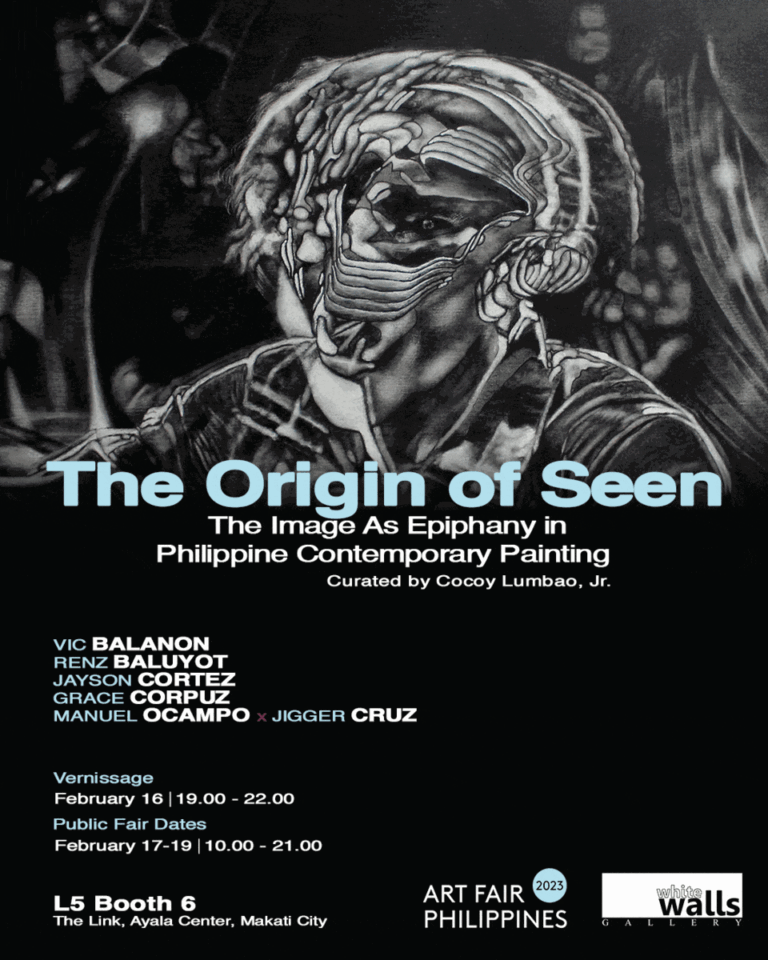
Art Fair Philippines 2023 Exhibition
The Link, L5 Booth 6
White Walls Gallery
February 17-19, 2023
The Origin of Seen: The Image As Epiphany in Philippine Contemporary Painting
Featuring works by
Victor Balanon
Renz Baluyot
Grace Corpuz
Jayson Cortez
Jigger Cruz and Manuel Ocampo
Anton Chekhov’s stories have paved the way for realist fiction, especially the short form, to present a different kind of ending or epilogue which does not necessarily provide a conventional resolution to the narrative (i.e. the death or triumph of the hero). His stories are concluded by the main characters’ epiphany, which instead emphasizes the unresolvable conflicts in life or the changes or continuation of a character’s attitude towards life. The ‘short form’ of stories—as opposed to the arching narrative tropes of the novel—is in itself an instance for continuation, since it can only depict a fragment of one’s life-event. Modernist writers such as Anton Chekhov, through their chosen method of writing fiction, which is the short story form, tend to see the value in presenting these fragments as a reflection of life’s banality. The short form in fiction, we can say, is a testament to the material condition of art as a form of labor during Chekhov’s lifetime, who is less assured of economic stability for sweeping ambitions granted to the longer form of novels and epic poems.
Finding such an equivalent in Philippine Art today, we can also turn into paintings to see these fragments of vision that follow unconventional tropes. Choosing ambiguity over dramatization, particularity over pastiche, these visual epiphanies tend to focus on singular moments—decisive moments within the realm of images that are then manifested into the canvas. These visions can be construed as articulating the ‘epiphanic’ in its modern sense which may mean ‘a certain realization, or a moment of burgeoning clarity.’ In the creation of pictures, a strong and seemingly concentrated effort to capture this moment is thus translated into sparse yet stark compositions—-arresting, but only through their vagueness or uncertainty, or through their dreamlike simplicity.
The word epiphany is derived from the Greek word, ‘epiphaneia,’ which means ‘appearance’ or a ‘manifestation.’ The turn of events in certain stories usually lead the main character to a sudden realization or insight, either about his own outlook in life or about other people’s predicament. The epiphany, as a literary device, is explored here as a kind of sensibility that can also find its way through image-making, as an innovative mode in exploring realist traditions in art. Through this group exhibition of selected artists, this mode can be explored through their different manifestations: through the fragmented ambiguities of Manuel Ocampo’s depiction of abject vistas—coupled with Jigger Cruz’s ability to react to this realized view via collaboration; through Jayson Cortez’s juxtapositions of portraiture and fantasy; through Renz Baluyot’s engendering of enthrallment via singular objects or occurrences; in Grace Corpuz’s depiction of peasant workers as attaining their own emancipations; and in Vic Balanon’s compositions—which combine the autobiographical alongside the world of cinematic tropes and fiction.
These are examples of worlds and realities that come from such receptive state, from realizations waiting to happen—as epiphanies—that are always in flux, always yet to be captured. Always, remaining to be seen:
/CLJ

